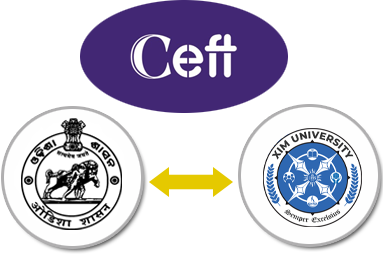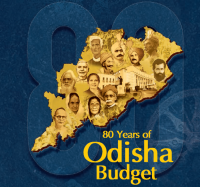Publications
- An empirical analysis of the effect of public debt on economic growth in India in the post-reform era. Asian Economic and Financial Review. 2016 Nov 1;6(11):692-705. https://doi.org/10.18488/journal.aefr/2016.6.11/102.11.692.705
- Bank credit and economic growth: An empirical evidence from Indian states. International Journal of Current Research. 2016; 8(9): 39145-39151. Retrieved from https://www.journalcra.com/sites/default/files/issue-pdf/17391.pdf
- Cointegration between government expenditure and revenue: Evidence from India. Advances in Economics and Business. 2017;5(1):33-40. https://doi.org/10.13189/aeb.2017.050105.
- Revisiting the causal nexus between savings and economic growth in India: An empirical analysis. Economia. 2017 Sep 1;18(3):380-91. https://doi.org/10.1016/j.econ.2017.05.001
- Revisiting the Financial Year in India. Archives of Business Research. 2016, 4(6). https://doi.org/10.14738/abr.46.2406
- The Long-run Causal Nexus between Expenditure in Social Services Sector and Economic Services Sector: A comparative analysis between national and sub-national governments. International Research Journal of Marketing and Economics. 2016; 3(12): 63-77.
- Fiscal Landscape of Odisha: An analysis of Deficits and Expenditures. International Journal of Research in Economics and Social Sciences. 2016, 6 (12):1-20. Retrieved from https://euroasiapub.org/wp-content/uploads/2016/12/1ESSDec-4286-1.pdf
- Causal Nexus Between Growth and Savings in India Using Nonlinear Causality Approach. International Journal of Research Methodology in Social Science. 2016; 2 (1):6-18.
- Impact of Public Debt on Economic Growth: Evidence from Indian States. Vilakshan: The XIMB Journal of Management. 2016 Sep 1;13(2).
- Fiscal Performance Index of the States in India. Praj̄nȧn: Journal of Social and Management Sciences. 2016 Oct 1;45(3): 247-266.
- Determinants of non-performing loans in India: A system GMM panel approach. Prajnan: Journal of Social and Management Sciences. 2018 Apr 1;47(1):37-56.
- Causal Nexus between Billing Efficiency and Economic Growth in India: An Analysis Using Vector Autoregression. International Journal of Economics and Finance. 2017;9(3):184-93. https://doi.org/10.5539/ijef.v9n3p184
- Impact of non–tax revenue on revenue expenditure in sub-national public finance in the economic sector. IOSR Journal of Economics and Finance. 2016;7(5):47-62. https://doi.org/10.9790/5933-0705014762
- An empirical analysis of the aggregate import demand function for India. Global Economy Journal. 2017 Dec 20;17(4):20170049.https://doi.org/10.1515/gej-2017-0049
- Is fiscal policy pro-cyclical or counter-cyclical? Evidence from India. Arthshastra Indian Journal of Economics & Research. 2017 Apr 1;6(2):7-19. https://doi.org/17010/aijer/2017/v6i2/114124
- Does the Union Budget 2016-17 reflect the True Spirit of Fiscal Federalism in India? The International Journal of Social Sciences and Humanities Invention. 2016; 3 (9). Retrieved from https://valleyinternational.net/index.php/theijsshi/article/view/571
- Efficiency in Value Added Tax in Sub-National Governments in India: An Empirical Analysis. VISION: Journal of Indian Taxation. 2017;4(2):1-9. https://doi.org/10.17492/vision.v4i02.11779
- The Nexus between Fiscal Decentralisation and Economic Growth: Evidence from Sub-National Governments in India. International Journal of Research and Innovation in Applied Science. 2017; 2 (1):1-4. Retrieved from https://rsisinternational.org/journals/ijrias/DigitalLibrary/Vol.2&Issue1/01-04.pdf
- Does inflation affect savings non-linearly? Evidence from India. Margin: The Journal of Applied Economic Research. 2018 Nov;12(4):431-57. https://doi.org/10.1177/0973801018786155
- ‘Surge’ pricing for railway tickets as a tax by Stealth. Economic and Political Weekly. 2018;53(5):25. https://www.epw.in/journal/2018/5/commentary/%E2%80%98surge%E2%80%99-pricing-railway-tickets-tax-stealth.html
- Has the Feldstein-Horioka puzzle waned? Evidence from time series and dynamic panel data analysis. Economic Modelling. 2019 Dec 1; 83:256-69. https://doi.org/10.1016/j.econmod.2019.02.015
- New evidence on the relationship between public and private investment in India. Economics Bulletin. 2019 Sep 3;39(3):1989-2001. Retrieved from https://www.accessecon.com/Pubs/EB/2019/Volume39/EB-19-V39-I3-P187.pdf
- Monetary policy and financial stability: The role of inflation targeting. Australian Economic Review. 2020 Mar;53(1):50-75. https://doi.org/10.1111/1467-8462.12348
- Central transfer a curse or blessing? Evidence from the relative revenue effort of Indian states. Australian Economic Review. 2020 Jun;53(2):214-27. https://doi.org/10.1111/1467-8462.12358
- Post-Crisis India’s Merchandise Export Growth: What Has Changed? The Indian Economic Journal. 2018 Dec;66(3-4):270-93. https://doi.org/10.1177/0019466219880132
- Has the FRBM rule influenced the fiscal deficit-growth nexus differently in India? Macroeconomics and Finance in Emerging Market Economies. 2020 Jan 2;13(1):53-66. https://doi.org/10.1080/17520843.2019.1677736
- Threshold level of fiscal deficit: revisiting FRBMA limit in Indian states. Journal of Social and Economic Development. 2020 Dec;22(2):233-49. https://doi.org/10.1007/s40847-020-00100-6
- Employment and economic growth dynamics in Odisha, India. Journal of Public Affairs. 2021 May;21(2):e2168. https://doi.org/10.1002/pa.2168
- Gender-based wage discrimination in the Indian urban labour market: An assessment. The Indian Journal of Labour Economics. 2019 Sep;62:361-88. https://doi.org/10.1007/s41027-019-00175-8
- Concerns around the NDHM. Economic Political Weekly. 2020 Sep; 55(36). Retrieved from https://www.epw.in/journal/2020/36/letters/concerns-around-ndhm.html
- COVID-19 and the Challenges of Virtual Mode of Education in India. Azim Premji University Practice Connect 2020.
- Does petroleum tax revenue drive sales tax effort of Indian states? A stochastic frontier approach. International Journal of Finance & Economics. 2022 Jan;27(1):1257-68. https://doi.org/10.1002/ijfe.2212
- Examining calorie undernourishment in India: Is it due to choice or inadequacy? Nutrition and Health. 2021 Mar;27(1):17-26. https://doi.org/10.1177/0260106020949739
- Impact of COVID-19 on the Tourism Sector. The Economic and Political Weekly, 2020 July; 55(30). Retrieved from https://www.epw.in/journal/2020/30/letters/impact-covid-19-tourism-sector.html
- Poverty and inequality in Odisha, India. Journal of Public Affairs. 2021 May;21(2):e2220. https://doi.org/10.1002/pa.2220
- The long‐run effect of public debt on economic growth: Evidence from India. Journal of Public Affairs. 2022 Feb;22(1):e2281. https://doi.org/10.1002/pa.2281
- A poverty decomposition analysis for the northeastern region of India. Review of Development and Change. 2020 Dec;25(2):237-55. https://doi.org/10.1177/0972266120979429
- Evidence-Based Suggestions to Improve UGC JRF-NET Examination (March 29, 2020). Available at SSRN: https://ssrn.com/abstract=3563576 or http://dx.doi.org/10.2139/ssrn.3563576
- What Does the Debt Burden Index of Eighteen Major States of India Reveal? 2005–2006 to 2018–2019. The Indian Economic Journal. 2021 Mar;69(1):105-22. https://doi.org/10.1177/0019466220987029
- Labour force and employment growth in India. Economic & Political Weekly. 2021 Nov 20;56(47):58-63.
- Introspecting Human Development. Economic & Political Weekly. 2021 Jan 23;56(4).
- Evolving Inequalities. Economic & Political Weekly. 2021 May 08;56(19).
- The impact of income on public health and education expenditure: Evidence from the Indian states. Journal of Public Affairs. 2022 Dec;22:e2757. https://doi.org/10.1002/pa.2757
- Assessment of living conditions of urban slum dwellers in India in the New Millennium. Urban Research & Practice. 2022 Aug 8;15(4):604-26. https://doi.org/10.1080/17535069.2021.1887923
- Effect of information and communication technology on the environmental sustainability: An empirical assessment for South Africa. Telematics and Informatics Reports. 2022 Sep 1;7:100013. https://doi.org/10.1016/j.teler.2022.100013
- Testing the impact of input and output substitutability in nonparametric production analysis: evidence from the life insurance industry in India. Journal of the Operations Research Society of Japan. 2022 Oct 31;65(4):172-97. https://doi.org/10.15807/jorsj.65.172
- Does petroleum tax revenue drive sales tax effort of Indian states? A stochastic frontier approach. International Journal of Finance & Economics. 2022 Jan;27(1):1257-68. https://doi.org/10.1002/ijfe.2212
- Nonlinear Dynamic Impact of Electricity Consumption on Economic Growth in Odisha: A Disaggregated Causality Analysis. International Journal of Economics and Finance. 2024;16(6):1-3. https://doi.org/10.5539/ijef.v16n6P13
- Demand-Side Determinants of Billing Efficiency in India: A Panel GMM Approach. International Journal of Economics and Finance. 2024;16(8):1-40. https://doi.org/10.5539/ijef.v16n8p40
- Fiscal autonomy and public expenditure performance: Some panel‐data evidence from Indian states. Bulletin of Economic Research. 2024 Oct;76(4):1065-93. https://doi.org/10.1111/boer.12460
- Is There a Systematic Bias in Budget and Revised Estimates of Gross Fiscal Deficit?. Asian Economics Letters. 2024 Nov 30;5(Early View). https://doi.org/10.46557/001c.123246
- Revisiting the fiscal performance of non-special category states of India: a global Malmquist index approach. Vilakshan-XIMB Journal of Management. 2024 Dec 24. https://doi.org/10.1108/XJM-03-2024-0047
- Collapse in Wage/Salary Income Growth in India, 2011-12 to 2017-18. IHD Working Paper, 01/2020
- Do Aggregate Technical and Commercial losses in the power sector converge across Indian states? (Energy Research Letters, Accepted and forthcoming). 2025





